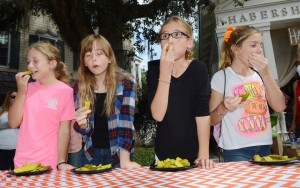Regional All-Natural Quick Service Chain Introduces the Jalapeño Cream Cheese Burger
DENVER, Oct 22, 2015 (BUSINESS WIRE) — Good Times Restaurants Inc. GTIM, +2.09% operator of Good Times Burgers & Frozen Custard, a Colorado favorite quick service restaurant chain best known for its fresh, high-quality, all-natural products, is firing up the month of October with the Jalapeño Cream Cheese Burger.
This Smart News Release features multimedia. View the full release here: http://www.businesswire.com/news/home/20151022005099/en/
The savory new burger features fire roasted jalapenos, fried red & green jalapeno sticks, cream cheese and raspberry jam. Available for a limited time, the new menu item will continue to uphold Good Times’ mission of offering fresh, all-natural, hand-crafted food using locally-sourced ingredients to create the tastiest fast food available. Similar to the everyday items on the menu, the Jalapeño Cream Cheese burger will be made with Good Times’ humanely raised, steroid-free beef.
“The Jalapeño Cream Cheese Burger is the perfect blend of sweet and spicy ingredients, and a Colorado favorite that you would otherwise only find in an upscale casual dining environment. Using ingredients you won’t find at any other fast food restaurant, I believe we have created a true one-of-a-kind menu item,” said Nick Biegel, Director of Product Development. “Our LTO offerings are a fun way to incorporate different local produce into our menu items. We’re looking forward to seeing if our customers love it as much as we do.”
Good Times continues its commitment to quality menu offerings with its completely all-natural protein platform, recently adding all-natural, nitrate-free bacon to the mix. The restaurant chain also recently introduced All Natural Housemade Pickles and Hand Breaded Fried Pickles, which are prepared in small batches by hand daily in each restaurant.
“Our brand position is based on the belief that food should be as fresh as possible, unique and of the highest quality,” said Biegel. “Every menu item that we have and will have in the future will be held to that standard in order to give our customer’s the best quick service experience possible.”
About Good Times Restaurants Inc.: Good Times Restaurants Inc. (GTIM) operates Good Times Burgers & Frozen Custard and was founded in 1987 in Boulder, Colorado. Good Times prides itself on serving fast food to be proud of by offering a high quality, fresh, unique, proprietary selection of hamburgers made with Meyer All Natural Angus beef, All Natural chicken tenderloins from Springer Mountain Farms, All Natural, Nitrate Free Bacon from Good Nature Farms, Hatch Valley Green Chile Breakfast Burritos, signature Wild Fries and Natural Cut Fries, Beer Battered Onion Rings and fresh, creamy Frozen Custard in a variety of flavors, Hand Spun Shakes and Spoonbenders. Good Times currently operates and franchises 38 restaurants.
GTIM owns and operates Bad Daddy’s Burger Bar restaurants. There are currently 14 company owned, joint ventured, franchised and licensed Bad Daddy’s open. Bad Daddy’s is a full service, upscale, “small box” restaurant concept featuring a chef driven menu of gourmet signature burgers, chopped salads, appetizers and sandwiches with a full bar and a focus on a selection of craft microbrew beers in a high energy atmosphere that appeals to a broad consumer base.
Good Times Forward-Looking Statements: This press release contains forward-looking statements within the meaning of federal securities laws. The words “intend,” “may,” “believe,” “will,” “should,” “anticipate,” “expect,” “seek” and similar expressions are intended to identify forward-looking statements. These statements involve known and unknown risks, which may cause the Company’s actual results to differ materially from results expressed or implied by the forward-looking statements. These risks include such factors as the uncertain nature of current restaurant development plans and the ability to implement those plans and integrate new restaurants, delays in developing and opening new restaurants because of weather, local permitting or other reasons, increased competition, cost increases or shortages in raw food products, and other matters discussed under the “Risk Factors” section of Good Times’ Annual Report on Form 10-K/A for the fiscal year ended September 30, 2014 filed with the SEC. Although Good Times may from time to time voluntarily update its forward-looking statements, it disclaims any commitment to do so except as required by securities laws.

